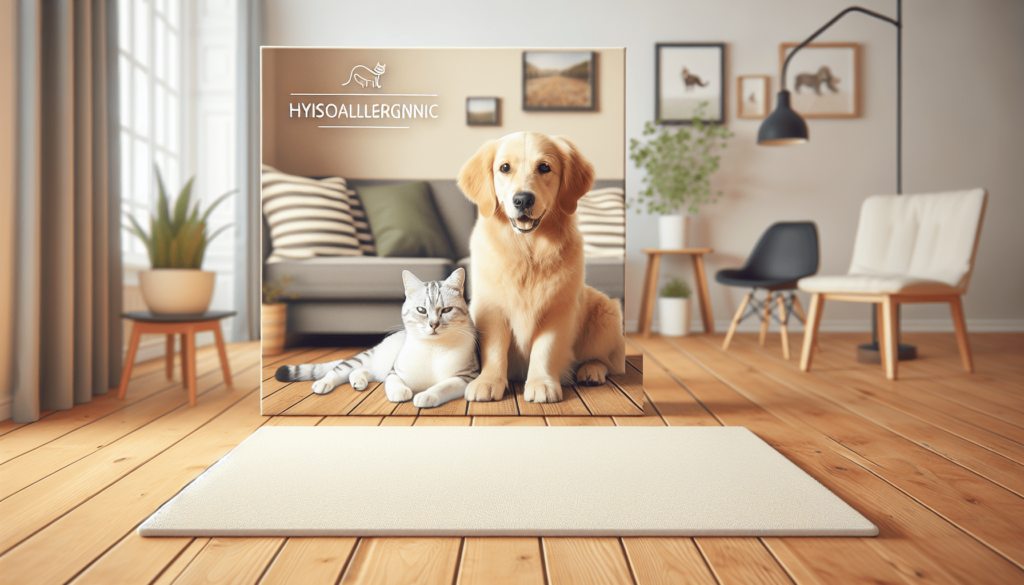Welcome to “Important Facts About Pet Allergies,” where you’ll uncover essential insights you need to know to manage and understand pet allergies better. Whether you’re a lifelong pet lover or considering adopting a furry friend, this guide will equip you with valuable knowledge about the causes, symptoms, and treatments for pet allergies. Get ready to navigate your way through key information that can help you maintain a harmonious home for both you and your pets. Have you ever wondered why you or someone you know sneezes or experiences itchy eyes when around pets? If so, you’re not alone. Pet allergies are a common problem that affects millions of people worldwide. Understanding pet allergies can help you manage symptoms and enjoy the companionship of pets without compromising your health.
Let’s dive into the world of pet allergies and unpack some important facts you should know.

What Are Pet Allergies?
Pet allergies occur when your immune system reacts to proteins found in the skin cells, urine, and saliva of animals. These proteins can cause symptoms ranging from mild discomfort to severe reactions. Common pets that trigger allergies include cats, dogs, rodents, and birds.
Common Symptoms of Pet Allergies
To identify a pet allergy, it’s helpful to recognize its common symptoms:
| Symptom | Description |
|---|---|
| Sneezing | Frequent sneezing fits, especially around pets |
| Runny or Stuffy Nose | Nasal congestion or a dripping nose |
| Itchy, Red, or Watery Eyes | Irritation in the eyes causing them to turn red or tear up |
| Skin Rash or Hives | Itchy patches on the skin, often in places where pets have licked |
| Coughing and Wheezing | Difficulty breathing or coughing fits |
| Shortness of Breath | Trouble catching your breath, particularly if you have asthma |
These symptoms can flare up immediately or hours after contact with a pet.
Causes of Pet Allergies
Identifying the root cause of pet allergies can be complex. Here are several underlying reasons why you might experience these allergic reactions:
Pet Dander
Pet dander consists of tiny, even microscopic, flecks of skin shed by cats, dogs, rodents, birds, and other animals with fur or feathers. These bits can cause your immune system to overreact when inhaled.
Saliva and Urine Proteins
When pets groom themselves, proteins in their saliva and urine can land on their fur and skin. Once these proteins dry, they can become airborne and cause allergic reactions.
Hair and Fur
While hair and fur themselves are not allergens, they can trap dander, saliva, and urine. Pet hair and fur can also collect pollen, mold spores, and other outdoor allergens, making things worse for those who are already allergic.
Diagnosing Pet Allergies
If you think you might have pet allergies, here are some steps to take:
See an Allergist
A professional allergist can help you determine the specific allergens that are causing your symptoms. They may use skin tests or blood tests to identify the culprit.
Skin Prick Test
In a skin prick test, your allergist will place a small amount of allergen on your skin and then prick the area with a needle. If you are allergic, you’ll likely experience a reaction, such as redness or swelling, at the test site within 20 minutes.
Blood Test
A blood test can measure the amount of specific antibodies in your bloodstream. Higher levels of certain antibodies can indicate an allergic reaction.
Managing Pet Allergies
So, you’ve been diagnosed with a pet allergy. What now? Here are some strategies that can help you manage your symptoms and keep your furry or feathered friends around:
Limit Exposure
Reducing your interaction with pets can significantly minimize symptoms. Avoid hugging, kissing, or allowing pets in bedroom areas.
Clean Regularly
Frequent cleaning can help reduce dander in your home:
- Vacuuming: Use a vacuum with a HEPA filter to trap airborne allergens effectively.
- Dusting: Use a damp cloth to dust surfaces to avoid stirring up allergens.
- Washing: Regularly wash your pet’s bedding, your own bedding, and any fabrics where your pet spends time.
Air Purifiers
HEPA air purifiers can help capture dander and other allergens floating around your home. Place them in rooms where you spend the most time.

Medications
Several medications can help alleviate your symptoms:
Antihistamines
Over-the-counter or prescription antihistamines can relieve sneezing, runny nose, and itchiness. Common ones include:
- Cetirizine (Zyrtec)
- Loratadine (Claritin)
- Fexofenadine (Allegra)
Decongestants
Decongestants can help reduce nasal congestion and are available in oral or nasal spray forms. Use them with caution as they can cause side effects like increased blood pressure and insomnia.
Nasal Steroids
Steroid nasal sprays can help reduce inflammation in your nasal passages. Common options include:
- Fluticasone (Flonase)
- Mometasone (Nasonex)
Allergy Shots
For more severe reactions, you may consider immunotherapy, also known as allergy shots. This involves a series of injections containing small amounts of the allergen, gradually increasing over time to help your immune system build tolerance.
Hypoallergenic Pets: Myth or Reality?
You’ve probably heard of hypoallergenic pets that supposedly do not trigger allergies. While no animal is completely hypoallergenic, some breeds are less likely to cause reactions. These breeds produce fewer allergens or have hair that traps fewer allergens.
Hypoallergenic Dog Breeds
| Breed | Characteristics |
|---|---|
| Poodle | Curly fur that traps less dander |
| Portuguese Water Dog | Dense, waterproof coat; sheds less |
| Schnauzer | Wire-haired; minimal shedding |
| Bichon Frise | Curly coat that produces fewer allergens |
| Maltese | Long, silky hair; doesn’t shed much |
Hypoallergenic Cat Breeds
| Breed | Characteristics |
|---|---|
| Sphynx | Hairless, making it easier to bathe and remove allergens |
| Devon Rex | Short, curly coat; sheds less and produces fewer allergens |
| Cornish Rex | Very fine, curly coat; lower allergen production |
| Balinese | Long-haired yet produces fewer Fel D1 protein |
| Russian Blue | Dense, short coat; produces less Fel D1 protein |
Living with Pet Allergies
Knowing you have pet allergies doesn’t mean you have to part with your beloved animal companions. Here are some additional tips for cohabiting with pets when you have allergies:
Create Allergen-Free Zones
Designate certain areas in your home, like your bedroom, as pet-free zones. This can give you a safe space to retreat when symptoms become overwhelming.
Grooming and Bathing
Regular grooming and bathing of your pet can reduce the amount of dander, saliva, and urine on their fur. For cats, who generally don’t enjoy baths, brushing can still significantly help.
Wash Hands and Clothes
Make it a habit to wash your hands after touching your pets. Also, regularly wash any clothing that comes into contact with them.
Consult Your Doctor
Always keep your healthcare provider in the loop about your allergen exposure and the severity of your symptoms. They can offer tailored advice and adjust your treatment plan as needed.
Psychological Impact of Pet Allergies
Living with pet allergies can also affect your mental health, particularly if you love animals. Here’s how to cope emotionally:
Building a Support System
Surround yourself with understanding family and friends who can help you manage your allergies. Having a support system can alleviate some of the emotional burden.
Alternatives to Pet Ownership
If managing symptoms around pets becomes too challenging, consider alternatives like volunteering at shelters, fostering pets for short periods, or even pet-sitting. This allows you to enjoy animal companionship without constant exposure.
Therapy and Counseling
If your allergies lead to significant lifestyle changes, don’t hesitate to seek professional help. Therapists and counselors can provide coping mechanisms and emotional support.
FAQs About Pet Allergies
To wrap things up, here are some frequently asked questions about pet allergies:
Can Pet Allergies Develop Later in Life?
Yes, it’s possible. Allergies can develop at any age, even if you’ve previously lived with pets without issues.
Are Small Pets Less Allergenic?
Not necessarily. Even small pets like hamsters and gerbils can produce allergens that trigger reactions.
Is There a Cure for Pet Allergies?
There is no cure, but effective management strategies and treatments can significantly reduce symptoms.
Do Hypoallergenic Pets Guarantee No Allergic Reactions?
No, but they may produce fewer allergens, making reactions less severe. Always spend time with a pet before deciding to bring them home to ensure you can tolerate them.
Can I Outgrow My Pet Allergies?
It’s rare but possible. Some people find that their allergy symptoms decrease over time, but others may experience worsening symptoms.
Understanding these important facts about pet allergies can help you lead a happier, healthier life—both for you and your animal companions. Managing pet allergies involves a combination of medical treatments, lifestyle adjustments, and emotional support. By staying informed and proactive, you can enjoy the company of pets without letting allergies dampen your spirit.
Whether you’re a seasoned pet owner or someone contemplating adopting a pet, knowing how to deal with pet allergies is crucial. Here’s to happy, healthy interactions with our furry and feathered friends!
